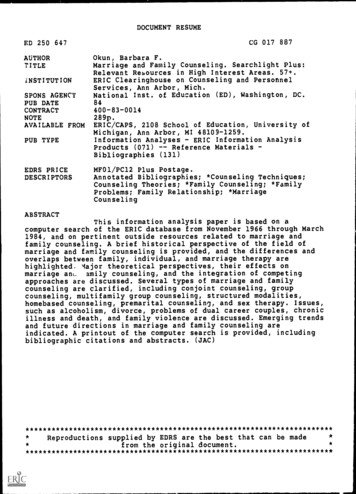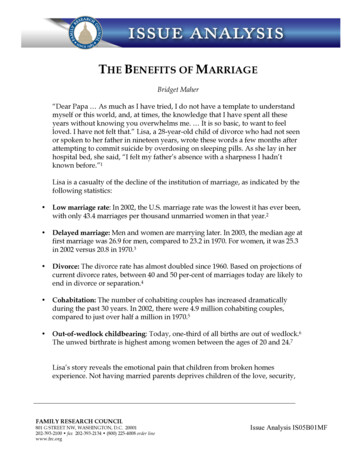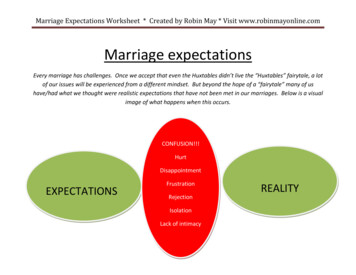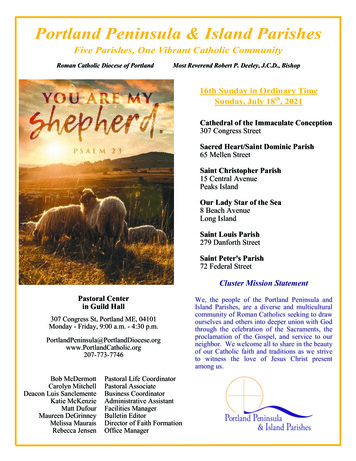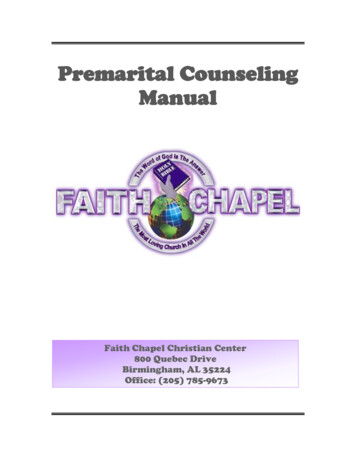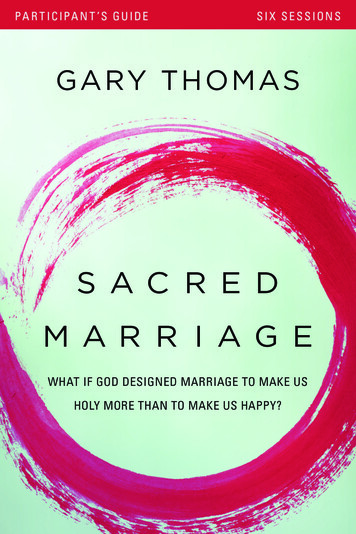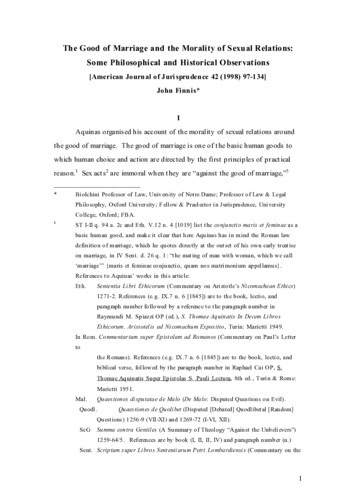
Transcription
The Good of Marriage and the Morality of Sexual Relations:Some Philosophical and Historical Observations[American Journ al of Juri spru den ce 42 (1998) 97-134]John Finn is*IAquinas organis ed his account of the morality of sexual relations aroundthe good of marriage. The good of marriage is one of t he basic human goods towhich human choice and action are directed by the first principles of pract icalreason.1 Sex act s2 are immoral when t hey are “against the good of marriage,”3*Bi olchini Professor of Law, Univers ity of Not re Dame; P rofessor of Law & LegalPhilosophy, Oxford Uni versity; F ell ow & Prael ector i n J uris prudence, Uni versityCollege, Oxford; FB A.1ST I-II q. 94 a. 2c and Eth. V.12 n. 4 [1019] lis t t he conjuncti o maris et feminae as abasic hum an good, and make it cl ear that here Aquinas has i n m ind the Roman lawdefinition of m arri age, which he quotes di rectly at the out set of his own early treat iseon marriage, in IV Sent. d. 26 q. 1: “t he mat ing of man wit h woman, which we call‘m arriage’” {maris et feminae conjuncti o, quam nos matri moni um appel lamus}.References t o Aquinas’ works in thi s article:Et h.Sententia Li bri Et hicorum (Com ment ary on Ari stotle’s Ni comachean Ethi cs)1271-2. R eferences (e. g. IX.7 n. 6 [1845]) are to the book, lecti o, andparagraph number followed by a reference t o t he paragraph number inRaymundi M. Spiazzi OP (ed. ), S. Thomae Aquinatis In Decem Li brosEt hicorum. Ar ist otel is ad Ni comachum Expos itio, Turin: Marietti 1949.In Rom. Commentar ium super Epist olam ad Romanos (Com ment ary on Paul’s Lettertothe R omans). References (e.g. IX.7 n. 6 [1845]) are to the book, lecti o, andbi bli cal verse, fol lowed by t he paragraph num ber in Raphael Cai OP, S.Thomae Aquinatis Super Epist olas S. Pauli Lectura, 8th ed. , Turi n & Rom e:Marietti 1951.Mal.Quaes tiones di sputatae de Malo (De Malo: Dis puted Ques tions on Evil).Quodl .Quaes tiones de Quoli bet (Disputed [Debated] Quodl ibet al [Random]Quest ions ) 1256-9 (VII-XI) and 1269-72 (I-VI, XII).ScGSumma contra Gentil es (A Summary of Theol ogy “Against the Unbeli evers”)1259-64/5. References are by book (I, II, II, IV) and paragraph number (n.)Sent. Scriptum s uper Li bros Sent enti arum Petri Lombardiensi s (C omm entary on the1
Sentences [Opinions or Positi ons of the Church Fathers] [Handbook ofTheol ogy] of Peter Lom bard [c. 1155]) I, 1253-4; II, 1254-5; III, 1255-6; IV,1256-7. References are by book (I, II, III, IV), di sti ncti on (d. ), ques tion (q.),article (a.) and somet imes to the response (s olut ion) t o a sub-questi on (sol.)STSumma Theologiae (A Summary of Theol ogy): I, 1265-8; I-II, 1271; II-II,1271-2; III, 1272-3. References (e.g. I-II q. 2 a. 2c & ad 2) are to the fourparts (fi rst , first -of-the-second, second-of the-second, third), ques tion (q.),article (a.), corpus (c) [i.e. t he body of Aquinas’s response], reply (ad 1, ad 2,et c.) to a part icul ar, numbered obj ecti on (obj. 1, obj. 2, etc. ), and/ or to theprovi sional reply sed contr a (s. c.)Supp.Suppl ementum (A Supplement t o [or rather, a part ial com pletion of] S T,posthumously and anonymously constructed from pas sages of IV S ent .)Ver.Quaes tiones Di sputatae de Verit ate (De Verit ate Di sputed [Debat ed]Quest ions on Truth).2By “s ex act” (and “(have) sex” used synonymously wit h t hat phrase) I shall here al waysmean an act or sequence of performances engaged i n with the intention or wi llingnessthat it s ecure orgasmi c s exual s ati sfaction for one or more person doing or participatingin the act. This i s s ubs tant ial ly the concept em ployed als o by Aquinas: see ST II-II q.154 a. 4; Mark Jordan, The Invention of Sodomy in Christ ian Theology (Universi ty ofChicago P res s, 1997), 156, is entirely mis taken i n clai ming that Aqui nas has “no otherway of di sti nguishi ng the class of acts , pleasures, and sins as venereal ” t han by“relation to the teleology of reproduct ion”, and “no category of the sexual apart fromanimal teleology”. Aquinas, l ike the moderns (“us ”) wit h whom Jordan is striving t ocontrast him , has a st rai ghtforward concept of sexual ( “venereal”) act s: thos e i ntendedto arouse or experi ence s exual pleasure, viz. the ki nd of i ntense pleasure associatedwi th orgasm – i .e. wit h t he ejaculation of male or female s emi nal fluids : S T II-II q.152 a. 1c & ad 4; q. 154 a. 4c & ad 2; IV Sent. d. 33 q. 3 a. 1 ad 4 & ad 5; onfemal e semen and orgas m s ee n. 125 below. Not e t hat the defini tion I have given of“s ex act” is morall y neut ral: moral ly good marital i ntercourse i s one kind of sex act.(And see my Aquinas: Mor al, Pol iti cal , and L egal Theor y (1998), ch. V.4 at n. 47. )The criti que of my views offered by Carlos A. Bal l, “Moral Foundations for aDi scourse on Same-S ex Marriage: Looking Beyond Polit ical Li berali sm,” GeorgetownLaw J ournal 85 (1997) 1872 at 1912-19, derail s ri ght from t he start by groundlessl yas sum ing that t he equi val ent defini tion of “homos exual sex act ” given in my “Law,Moral ity, and ‘Sexual Ori entation’” Not re Dam e Law R evi ew 69 (1994) 1049 at 1055“cont ains it s own buil t-i n moral di sapprobati on.”3This phrase (contr a bonum matri moni i) is used in relati on to adul tery, incl udi ngadult ery wit h t he s pouse’s consent (ST II-II q. 154 a. 8 ad 2 & ad 3; IV Sent. d. 33 q.1 a. 3 sol. 1 ( Supp. q. 65 a. 3) ad 5. The concept i s cl ose to the surface i n t he2
and t herefore unreasonable (and, inasmuch as unreasonable,4 unnatural).Considered p recisely as kinds of morally bad sex -- rather t han as , say, unjust (asrapes and some other morally bad sex acts obvious ly als o are) -- w rongful sexacts are more s eriously immoral the “more dis tant ” t hey are from marital s exualintercourse. 5 Aquinas ’ account of what it is to act sexually “against t he good ofmarriage” leaves a good deal to be clarified. But he did deploy a line of thoughtthat lawy ers and philosop hical t heologians had articulated in the precedingcentury, and that brilliantly illuminat es the way s in w hich sex acts, even whenperformed consensually between s pouses, can be against the good of marriageand t herefore unreasonable.Germain Grisez’s 1993 t reat ise on sex, marriage, and family life clarifieslarge tracts of sexual morality which A quinas ’ account left more or less obscure.For it shows how various kinds of s ex act, even w hen performed (e.g. as solitarydi scussion of m any kinds of s exual misdeed in ScG III c. 122; see text and not e 115below.4Aquinas’ moral arguments never run from “natural” to “t herefore reasonable and right, ”but always from “reasonable and right” to “therefore natural.” As he says, “moralprecepts are in accord wi th { consequuntur} human nature because t hey are therequi rements /prescript ions of natural reas on {cum si nt de di ctamine rationis naturalis }”:IV Sent. d. 2 q. 1 a. 4 s ol. 1 ad 2; li kewise, repeatedly, ST I-II q. 71 a. 2c (e. g.“virt ues. .are in accordance wit h human nature just ins ofar as they are in line wi threason; vices are agai nst hum an nat ure jus t i nsofar as they are against the order orreasonabl eness”); also q. 94 a. 3 ad 2; q. 18 a. 5c; q. 78 a. 3c; II-II q. 158 a. 2 ad 4(“the act ivi ty [of the capaci ty for anger] is nat ural t o human beings just insofar as it isin accordance with reason; insofar as i t i s outsi de the order of reas onableness it iscontrary to hum an nature”); F innis, Natur al L aw and Nat ural Right s (OxfordUniversit y P res s, 1980), 35-6. See als o t ext and notes nn. 58-65 below.5IV Sent. d. 41 a. 4 sol. 3c (“. .secundum quod magis di stat a matri moni aliconcubitu”); see al so Mal q. 15 a. 1c. Koppelman’s claim (56) that Aqui nas regardedhomos exual acts as “uniquely monstrous” is false: see S T II-II q. 154 a. 12; ScG III c.122; simi larly mist aken i s hi s clai m (i f he i ntends it, as the context s uggests , t o referto degree of gravit y) that Grisez holds that the considerat ions which show homosexualacts to be wrong “equal ly condemn other nonmarital s exual acts .” Gri sez, The Way ofthe L ord Jes us vol. 2 L ivi ng a Chris tian Li fe (F ranciscan Press, Qui ncy, Il linois ,3
masturbat ion, or homos exual s odomy) by unmarried people who have nointention of marrying, violate the good of marriage.” 6In 1994 I published an article w hich explored the reasons w hy “Plato andSocrates, Xenop hon, Arist otle, M usonius Rufus, and Plutarch, right at the heartof their reflections on t he homoerotic culture around t hem, make the verydeliberat e and careful judgment that homos exual conduct (and indeed all extramarit al7 s exual grat ification) is radically incapable of participat ing in, actualis ing,the common good of friendship .”8 T he article then cons idered why homosexualconduct is “ never a valid, humanly acceptable choice and form of life” and is(rightly) “repudiat ed as dest ructive of human character and relat ions hip s”. Theprimary reas on I summaris ed t hus :“it t reat s human sexual capacities in a way w hich is deeply hostile t o t heself-underst anding of those members of the community who are w illing tocommit thems elves t o real marriage in t he underst anding that its sexualjoys are not mere inst ruments or accomp animents t o, or merecompensat ions for, the accomp lis hment of marriage’s res pons ibilit ies, butrather enable t he s pouses to actualize and exper ience their int elligentcommitment t o s hare in those res ponsibilit ies , in that genuine selfgiving.”9To emphas ise the point , I added:1993), 654 (a page cit ed more than once by Koppelman) expl icit ly says thathomos exual acts are generical ly “more unreasonabl e” than forni cat ion.6Grisez, Li ving a Chr ist ian Lif e 633, 649. Grisez’s treati se i s t heologi cal , but t herelevant phi los ophi cal arguments and consi derations can be dis tinguis hed and detachedby careful anal ysis , and my own dis cuss ion in thi s arti cle is res tricted to phi los ophicaland historical cons iderat ions and m ethod.7In that arti cle I used “extra-marit al” to refer t o all non-marital sex acts ; in the presentarticle I shall use “extra-marit al” to refer to adul terous sex acts, a s ub-clas s of “nonmarit al” sex acts.8Fi nni s, “Law, M oral ity, and ‘Sexual Ori ent ati on’” at 1065.9Ibid. at 1069.4
“.t he deliberate willingnes s t o p romote and engage in homosexualacts.t reats human s exual capacit ies in a w ay w hich is deeply hostile tothe s elf-unders tanding of those members of the communit y who arewilling t o commit t hemselves to real marriage. . [It] is, in fact, a s tandingdenial of the intrinsic aptness of sexual int ercours e t o actualiz e and in t hatsense give expression to the exclus iveness and op en-ended commitment ofmarriage as something good in it self.”10Thus, like A quinas and Grisez , I argued that approval of homos exual and othernon-marit al sex act s is not s imp ly non-marital, in t he sens e of being ut terlyincap able of consummat ing or act ualizing t he human good of marriage, butactually “contrary to” or “violative of” t hat good.11Andrew Koppelman now offers a critique of Aquinas , G risez, and mewhich overlooks this cent ral argument entirely.12 He cons tructs for Aquinas asex ethics based on alleged p rincip les -- about respect for “the natural order ofthings”, or “normality ” -- w hich are remote from those which Aquinas actuallyemploys in his account of why some sex act s are morally unacceptable. H e s ays(41) “the fatal gap in [A quinas’] argument .is his failure to show w hat humangood will be frustrated by homos exual conduct ”, but he never ment ions Aquinas’treat ment of the good of marriage or Aquinas’ thesis that morally bad sex iscontrary to that good. Or my own similar t hes is. Similarly, w hile quoting manysnipp ets from G risez, Koppelman neglects to mention Grisez’s primary thesis10Ibid. at 1069-7011I als o indicated that non-marital, incl udi ng homosexual , sex acts are im moral becausethey viol ate inner int egrity and entail preferring an i llus ory instantiation of a bas ichuman good t o a real i nst anti ati on of t hat or som e other human good: ibi d. at 1069.These elements of m y posi tion are devel oped further in Patrick Lee and R obert P .George, ”What S ex Can Be: Self-Alienat ion, Il lus ion, or One-F lesh Unity”, Am. J.Juris . 42 (1998) . I s hal l here say li ttle or nothing m ore about them. But notethat Koppelman’s statement of the argument about di sintegrity (Koppelman, , textbetween nn. 143 and 144) misapprehends it.12‘Is M arri age Inherentl y Heterosexual?, ’ Am. J . Juris . 42 (1998) . Parent het icalnumbers i n m y article are to the pages of his art icl e.5
and argument . He fois ts on G ris ez and me an argument about sex and p leasure(and the “experience machine”), an argument he const ructs largely from bits andpieces of earlier p hilosophical writings (mos tly of mine) in w hich sexual moralitywas not t he iss ue. Like the scholars on w hom he heavily relies -- John Noonanand J ohn Bos well -- Koppelman is unaware t hat Aquinas’ treatment of t heradically different ways in w hich s ex can be for pleas ure s heds much light on t hewhole question of t he good of marriage and the ways in which t hat good can beviolated. 13A good many parts of Koppelman’s ess ay I shall scarcely ment ion. Noone need be det ained by its reflect ions on the supposed incomp atibility bet weenevolution (“ Darwin”) and Aquinas ’ fifth argument for the exist ence of God;14 orby it s adopt ion of Ron Garet ’s home-made t heology of sacrament al grace; or byit s fragment ary review of the ps ychological literature on t he effects that choicesto engage in homosexual conduct have on character, family, 15 and society ; or by13When I wrote “Law, Morali ty, and ‘S exual Orientation’” I was by no m eans as keenl yaware of the power of Aquinas ’ t reatment of t he good of marriage as I becam e inwriti ng chapter V.4 of my Aquinas: Mor al, Pol iti cal , and L egal Theor y (1998).14Wi th Koppelman p. at n. compare the statem ent of Darwin’s friend andcolleague, t he leading Am erican bot anis t and evol uti oni st As a Gray, in 1874: “Let usrecognize Darwi n’s great service to Nat ural S cience in bringing back to it teleology; sothat, ins tead of Morphology versus Teleology, we s hall have Morphol ogy wedded toTeleology.” And Darwi n’s res ponse: “What you say about Teleology pl eas es mees peciall y, and I do not think any one els e has ever noticed t he point.” F or t he sourcesand i llum inating di scussi on of related sources and i ssues, see Leon R . Kass,“Teleology and Darwin’s The Origi n of Speci es: Beyond Chance and Neces sity?” inSt uart F. Spicker (ed. ), Or ganism, Medicine, and Metaphys ics : Es says in Honour ofHans Jonas (D. Reidel, Dordrecht and B oston, 1978) 97-120 at 97-8.15Koppelman more than once cites C harlott e J . P atterson, “Chi ldren of Lesbian and GayParents,” Child Development 63 (1992) 1025 as his authority for s tati ng that“s tudies. .have found” e. g. that “chi ldren rais ed by same-sex coupl es develop just aswell as. .children of opposit e-s ex couples ” (11) n. 34, (21) n. 66. The sl enderness ofthe bases for t his “fi ndi ng” is stated even i n Patterson’s own articl e at pp. 1028-9 and1036:“systemati c empi rical s tudy of these iss ues is jus t begi nning. . Studies in thi s area[scil. gay fathers] are st ill rat her scarce. . the preponderance of research to date6
it s creditably tent ative re-run of the manifestly sophistical argument t hat law sacknowledging or defining marriage as a relat ions hip between a man and awoman 16 discriminat e irrat ionally on grounds of s ex. 17 One can, however, learnhas focus sed on chi ldren who were born in the context of heterosexualmarri ages , whos e parents divorced, and whose mothers have i dentifiedthems elves as l esbi ans . . . Two reports (McCandlis h, 1987; St eckel, 1987)have focused on chi ldren born to lesbians in the context of ongoi ng l esbianrelat ions hips. Of [si c] the many other ways in which children mi ght com e t obe brought up by lesbi an or gay parents (e.g. through foster parenting,adopt ive parent ing, coparenti ng, or mul tiple parenti ng arrangements), nosystemati c research has yet appeared. . . most [studies] compare children indi vorced les bian mother-headed fami lies wi th chil dren i n di vorced het erosexualmother-headed famil ies . . . A parti cularly notabl e weakness of existi ng res earchhas been the tendency in most st udi es t o compare development among childrenof a group of divorced lesbian m others, many of whom are li ving with les bianpartners, to that among children of a group of di vorced het erosexual mot herswho are not current ly living wit h heterosexual partners .”As was the case wit h divorce’s now well -docum ented bad effects on chi ldren, it may take s omedecades for sociological research t o catch up wit h real ities which were alwayspredi ctable and predicted by reflective and m oral ly-sensiti ve com mon-sense.16In this arti cle I s hal l not be cons idering what t he law is or should be. F or m uchinformati on and good s ens e on those iss ues , s ee Davi d Orgon Coolidge, “Same-SexMarri age? Baehr v. Mi ike and the Meaning of Marri age, ” S out h Texas L. Rev. 38(1997) 1-119.17The s ophi sm is easi ly det ected once one reali ses that “discrim inates on grounds of sex”is shorthand primarily for “discrim inat es against women (and i n favor of men) on thegrounds t hat they are fem ale, or agains t m en (and in favor of wom en) on the groundsthat they are m ale. ” Of course, anti-discrim inat ion laws charact eris ticall y em brace(s ometimes j ust ifiably) certain secondary forms of “dis crim ination”, viz. disti nct ionbetween pers ons on the basis or grounds of certai n characteris tics (other t han mal enessor femalenes s) which de facto are possessed only or dis proport ionatel y by m ales [or, asthe case may be, femal es]. B ut even this secondary sense of “dis crim ination ongrounds of s ex” sti ll has not hing t o do wi th dist inguis hing the relat ionshi p betweenhusband and wife from all other forms of relationshi p on the ground t hat only ahusband-wife relati ons hip can be marri age (and that m arriage deserves a kind and degreeof legal support which ot her partnershi ps do not). Koppelman goes some way t owardsrecognisi ng and conceding thi s i n his remarks about “the underlyi ng purposes of sexdi scriminati on law” and i n hi s evident unease in the face of t he thought “t hatdi scriminati on agai nst gays has not hing to do wit h s exi sm as s uch,” i n Koppelman,7
somet hing from observing how comprehens ively the tradit ional ethics ofsexuality can be, and is, mis stated by scholars w ho critique it in the name ofmore (Bos well and Koppelman) or less (Noonan) radical reform. In s ect ions IIand III I shall consider that critique. In s ection IV I shall sketch an argument rest ating t he relationship betw een that t raditional et hics of sexuality and t he goodof marriage. In section V I s hall s ay s omething about s ame-sex imitat ions orcaricatures of marriage.IIIn his immensely influent ial book Contr aception, which manifes ts afamiliarity wit h Aquinas’ works far greater t han Bos well’s or Koppelman’s,John Noonan claimed that for Aquinas it is a sin, “at least venial”, to seekpleas ure in marital intercourse. 18It is in fact quite clear that A quinas thought it entirely reasonable to beinterested in and motivat ed by t he pros pect of enjoy ing the pleas ures of maritalsexual intercourse. 19 Noonan is well aw are of this. So he holds that Aquinas“Three Argum ent s for Gay Rights, ” M ichi gan L. Rev. 95 (1997) 1636 at 1662 and n.113. Arguments that dist inguishing marriage from heterosexual or hom osexualconcubinage is per s e discrimi nat ing in favor of men are a sign of desperat ion.18John T. Noonan Jr., Contr aception: A Hi story of Its Treatment by the Cat hol icTheol ogians and Canoni sts (Harvard Uni versity Press , 1965 and 1986) 250 (the viewthat “label ed t he int enti on to seek pl eas ure in int ercours e as venial. .was held steadil yby. Thom as, On the Sentences 4. 31. 2.3”); 294 (“Why was it, according to Thomas , atleast venial si n to seek pleasure?”); 295.19See IV Sent. d. 31 q. 1 a. 1 ad 1 ( Supp. q. 49 a. 1 ad 1): as hunger m akes usinterested i n eating { ad excit andum ad comes tionem} , s o di vine provi dence hasat tached pleasure t o m ari tal int ercours e t o i nterest us in engagi ng i n generati ve types ofact { ad excit andum ad actum }; d. 26 q. 1 a. 4 obj. 5 & ad 5 ( Supp. q. 41 a. 4 obj.5 & ad 5); S upp. q. 65 a. 4 ad 3 (cf. IV S ent . d. 33 q. 1 a. 3 sol. 2 ad 3). M orallygood mari tal intercourse shares wit h ot her sex acts the choice and purpose{propositum} of orgasmi c pleas ure {talem delectati onem}: see ST II-II q. 152 a. 1c.See also Ver. q. 25 a. 5 ad 7: when what is rightly desired has been settl ed by reas on[scil. int ercourse between us as soon as appropriate, as an act of marital fi des ], then8
simply contradicts himself (w ithin a couple of pages !) on t he propriety ofseeking s exual pleasure.20 No such contradiction exist s. The only text whichNoonan cites to sup port his claim t hat Aquinas rejects sexual pleasure as alegit imat e motive for marital intercourse is a text concerned, quite exp licitly , w itha rat her different question: Is it wrong t o make sexual pleasure one’s sole motivein or for intercourse. 21 The ans wer is , Yes. But only aft er a careful explanationof what it means to make pleasure one’s exclusive motive. In relation tointercourse bet ween sp ous es, that means one or ot her of two kinds of thing, say sAquinas. At best, one is not interested in or concerned with any thing aboutone’s spouse ot her than w hat one would be concerned wit h in a prostit ute orgigolo;22 in other w ords, one’s s exual activity is seeking, not to exp res s affectionfor or commitment t o t he one person who is one’s spouse, but t o get p leasure. Iteven though one’s bodi ly appetit e i s arous ed towards it there is nothing wrong wit h allthat {tamet si sensualit as in id ferat ur, nullum erit peccatum} . Uni vers all y, “part of t hefullness of the morall y good is that one i s m oved to the good [wi th which a particularact i s concerned] not onl y by one’s wil l but also by one’s sense appetit es, one’s flesh:”I-II q. 24 a. 3c. And universal ly, ‘it is natural t o us as rational ani mal s that our powerof desiri ng {[vi s] concupiscibi lis } be drawn towards what is sensual ly enj oyable {indelectabi le sensus} i n l ine wit h reas onable order { secundum ordinem rationis} ’: Mal .q. 4 a. 2 ad 4 [or: ad 1].20Contr aception 294 (“A cont radicti on exi sted between [Aquinas’] statem ent [Sent.4. 31. 1.1] that God int ends sexual pleas ure to be an inducem ent and [his] st atem ent[S ent . 4. 31. 2.3] that to act for sexual pl eas ure in marriage i s evil. ”) Noonan offers toresol ve t he contradict ion for Aquinas by s uggesti ng that Aquinas should, on his ownprinciples, abandon the first of these two [alleged] st atem ent s (which, Noonan oddlythinks, “was a departure from Arist otel ian princi ple”)! (id.)21IV Sent. d. 31 q. 2 a. 3 ( Supp. q. 49 a. 6): the quest ion in iss ue is defi ned at thebeginning of the article as t o what ext ent it is sinful “for s omeone to have intercoursewi th his wife, not i ntending t he [ or: a] good of marri age but ONLY pl eas ure [solamdelectati onem]”. The reference to pleasure being the s ole mot ivation is repeat edthroughout t he discuss ion (see objs. 1, 2 and 4), though occasi onal references (e.g. obj.3) to “for t he sake of pl easure” show t hat the latter phras e i s, in t his context, to betaken narrowly, as equivalent to “for t he sake only of pleasure, and wit hout any i nterestin a mari tal good”.22IV Sent. d. 31 q. 2 a. 3 ( S upp. q. 49 a. 6) ad 1: “ni hil al iud in ea [scil. uxore]at tendit quam quod in meret rice at tenderet.”9
is de-personalized, and de-marit aliz ed. T here is a wors e kind of cas e: one is soconcerned with pleasure alone that one would be willing t o engage in intercoursewith some ot her att ractive and available p ers on, even s omeone not one’s spouse.In this case the pleas ure-driven de-personalizing and de-marit aliz ing has gone sofar t hat one’s sex act s, even though they are in fact w ith one’s spouse, are a kindof adultery, a serious violat ion of the good of marriage.That is w hat Aquinas means by having sex p recisely “ for the sake ofpleas ure”, i.e. solely for the sake of pleas ure—for pleas ure alone. Hiscondemnat ion of such de-p ersonalized and de-marit aliz ed sex act s is completelycompatible w ith his const ant thesis that p leasure is a prop er, indeedprovident ially appoint ed, 23 motive for engaging in marit al int ercours e.M oreover, Aquinas’ object ion to de-pers onaliz ed s ex has no exclus ive connectionwith pleasure, and manifests no special suspicion of pleasure. F or he makes itclear that t here is the s ame kind of wrong -- and venial or serious , depending onhow far one’s act is de-marit aliz ed--whenever one’s motive for engaging inintercourse is solely one’s healt h24 or solely “ cooling off”, i.e. t he reduction ofone’s own tempt ations to extra-marital sex.25At the end of his main discus sion of this kind of sexual immorality,Aquinas s ays that in acts of s uch a k ind 26 one “becomes ‘all flesh’.”27 A s ign ofNoonan’s far-reaching mis underst anding of Aquinas ’ entire account of sex is hisremark (citing this passage) that A quinas:23See note 54 below.24IV Sent. d. 31 q. 2 a. 2 ( S upp. q. 49 a. 5c) ad 4.25Ibid. ad 2.26IV Sent. d. 31 q. 2 a. 3 ( S upp. q. 49 a. 6c) ad 4: “in il lo actu”; il lo {“that”) refersback to t he obj ecti on, which defines the kind(s) of act in questi on as havi ng i ntercoursewi th one’s s pouse “sim ply from s exual desi re [or lus t]” (sola li bidine).27Contr aception 254. The internal quotat ion, which Noonan does not identify, is a st ockmedieval paraphrase of Augus tine, Sermon 162 (al. frag. 3 n. 2), PL 38 col. 887 (“sedsi mul totus hom o di ci possi t quod caro sit”), reflect ing on why St . P aul in ICorinthians 6: 18 cons iders fornication to be a s in against one’s own body.10
“treat s Augus tine as his t eacher on the effect s of sexual acts. H e repeats theAugus tinian epigram that in coit us man ‘becomes all flesh’.”28Even in A ugustine, how ever, t he “ep igram” concerns not coit us (sexualintercourse), w hich might be morally good or bad, but im mor al s ex acts : in t herelevant pas sage in Augus tine the immorality is fornication (especially thoughnot only as or with a prostit ute); in A quinas , as we have s een, it is having sexwith one’s s pouse as if he or she w ere a p ros titute. A quinas is perfect ly clear:an authentically marit al act of sexual int ercours e is an act w hich, s o far fromrendering the s pous es “all flesh”, enhances t heir sp iritual friendship w ith God.29Such a misreading bodes ill for Noonan’s understanding of A quinas ’ sex ethics -indeed, of t he whole tradition’s.Noonan’s mis takes about p leas ure as a motive are tightly linked w ith amore important thes is -- and a more profound mist ake. A quinas, he says:28Id. (the cit ati on t o ad 3 is a s lip for ad 4).29IV Sent. d. 26 q. 1 a. 4c ( Supp. q. 41, a. 4c), a text never ci ted by Noonan, thoughit is fundam ent al, and includes a t reat ment of preci sel y the s ame problem as the l ater“all fles h” pas sage in Supp. 49, 6. The whol e matter i s cl ear enough al ready (about 40years before these wri tings of Aqui nas) in the gl oss on Lom bard by Al exander of Hales(whos e work influenced Aquinas), IV Sent. d. 31 para. 10f (in relat ion to themerit oriousness of the marital act): “Though there i s m ore unity in marital s exualintercourse than there is in fornication, there i s no m ore carnality; so it i s i n deeds oflust, and not i n t he mari tal act, that ‘m an is all flesh’” (“In opere coniugali maior es tunio [than i n forni cat ion], quia unitas fi dei et unitas sacrament i. Sed li cet maior s itunitas, non tamen maior carnalitas; unde i n opere li bidinos o es t homo totus caro, nonautem i n opere matri moni ala.”).There is another passage where Aqui nas employs t hephras e “totus hom o caro efficitur:”: IV Sent. d. 27 q. 3 a. 1 s ol. 1c ( Supp. q. 66, a.1c). Here what “makes one al l fles h” i s agai n not coit ion as such, s til l l essauthenticall y m arit al int ercours e, but concupiscent ia, the lus t t hat incites s omeone tobi gam y; t hat lust can be complet ely abs ent from t hos e who are content wi th one wifeand need not be present i n those who legit imately remarry after t he deat h of theirspous e (s ee IV Sent . d. 42 q. 3 ( Supp. q. 63) a. 1c; in t he special context of t hemedieval canon-law rul es about rest rict ions on pries tly ordination being considered i nSupp. q. 66 a. 1, even a legi tim ate second marriage was , however, treated (i) as bei ngdefective as a sign of Christ ’s uni ty with hi s Church, and sim ilarly (ii ) as, in the or der11
“is defending the proposit ion that only a p rocreat ive purpos e excusescoitus. . Coit us is naturally ordained for p rocreation, and nothingelse.”30Koppelman, t oo, claims that for Aquinas “reproduction is.the only good thathumans can p urs ue by t he use of their s exual faculties” and desires for othergoods are unnat ural. But the very pass age cited here by Noonan is sufficient t odispose of both Noonan’s and Koppelman’s claims. F or it is in fact defendingthe contrary propos ition: that marital int ercours e is made right not only by t hesp ous es’ int erest in t he good of offspring (p rocreat ion) but also, andalternatively, by t heir interest in the good Aquinas calls fides – i.e.
7 In that article I used “extra-marital” to refer to all non-marital sex acts; in the present article I shall use “extra-marital” to refer to adulterous sex acts, a sub-class of “non-marital” sex acts. 8 Finnis, “Law, Mora
